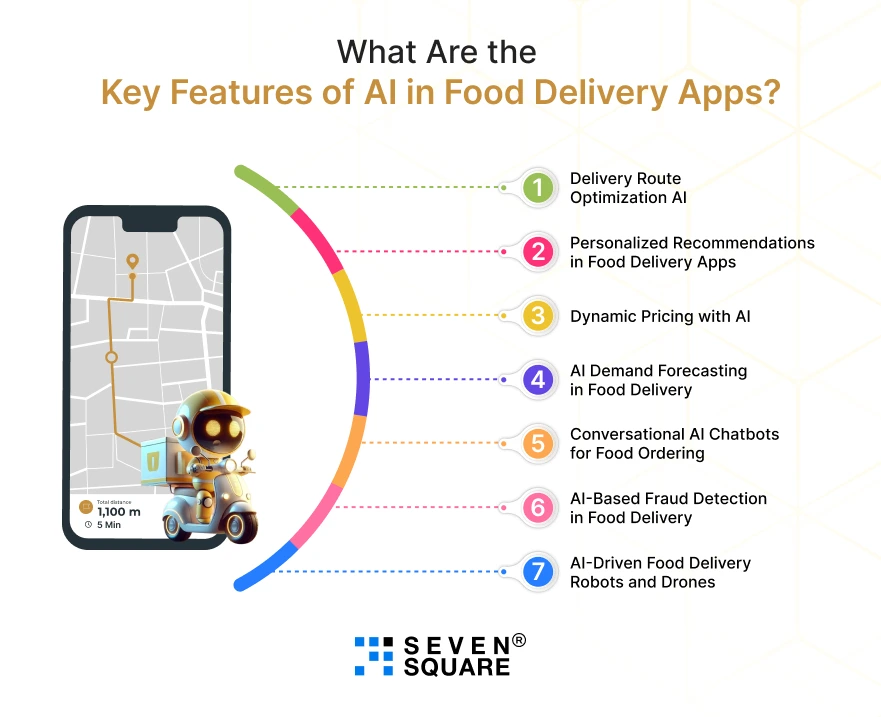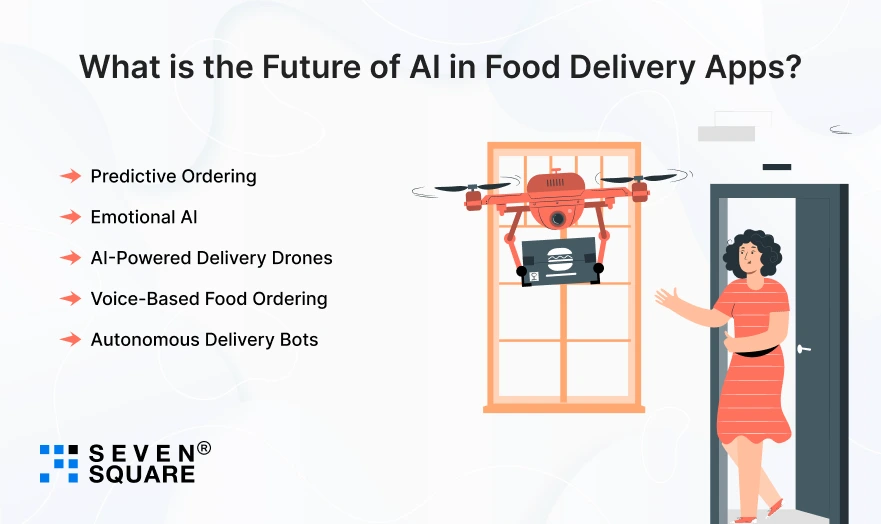The food’s cold again.
That’s not just a customer complaint, it’s a lost user. A lower rating.
And a painful reminder that logistics, personalization, and timing matter more than anything in food delivery.
If you’ve ever managed or scaled a food delivery app, you’ve likely felt this pressure.
Real-time route optimization, last-minute cancellations, overwhelming peak-time loads, & inconsistent user experience, it’s a puzzle that can’t be solved by code alone.
But artificial intelligence (AI) can make the difference.
At Seven Square, we’ve helped startups and enterprises build food apps that do more than just deliver. They adapt. Predict. Learn.
And most importantly, they earn user trust with every order. We integrate AI in food delivery apps that is a combination of logic, data, and UX design to deliver real impact.
Let’s explore how AI in food delivery apps is solving real-world problems, the features it brings, the benefits you can have, and where this tech is headed.
Why Traditional Food Delivery Apps Are Falling Behind?
The top complaint with most food apps? Unreliable experience.
Whether it’s a wrong ETA, a missing item, or poor support, these issues pile up. Why?
Because traditional systems work reactively, not proactively. They follow rules, but they don’t learn.
AI fixes that by allowing food delivery apps to think and respond in real time.
What Are the Key Features of AI in Food Delivery Apps?

Artificial Intelligence isn’t just a backend engine; it actively changes how users experience your food delivery platform from order to doorstep.
Here you can see the most important AI features you should know if you’re building or scaling a smart delivery system:
1. Delivery Route Optimization AI
Traditional delivery algorithms only calculate the shortest distance.
AI for delivery optimization, however, considers dynamic real-world variables like traffic patterns, weather disruptions, road closures, and even ongoing delivery queues of drivers.
The result? Fast, intelligent routing.
- Example: AI in Uber Eats and DoorDash uses machine learning to continually update routes based on real-time changes to ensure faster and more reliable deliveries.
This kind of smart delivery system drastically cuts delivery time and improves customer satisfaction. When users get hot meals on time, retention goes up.
Learn to automate route planning with Smart Logistics Software.
2. Personalized Recommendations in Food Delivery Apps
AI-based personalization is what keeps customers coming back.
It learns from your users’ ordering behavior, what they ordered, when, how frequently, their dietary preferences, and even trending items nearby.
AI personalization in food apps shows users meals they are most likely to crave.
- Think of it like Netflix suggestions but for food.
- Personalized recommendations in food delivery apps often increase cart values and lower bounce rates.
By going into user preferences, your food app can improve average order value through subtle upselling and meal pairings.
3. Dynamic Pricing with AI
Dynamic pricing in food delivery apps uses AI to adjust meal prices in real-time.
Factors like location-based demand, inventory levels, delivery time estimates, and competitor pricing data are all analyzed instantly.
- Example: On rainy evenings or during major TV events, AI adjusts pricing slightly upward to maximize margins while still offering value.
This AI feature not only improves revenue for platforms and restaurants but also keeps your app agile in a competitive market.
4. AI Demand Forecasting in Food Delivery
AI-powered demand forecasting helps restaurants and cloud kitchens predict what items will be popular and when.
This allows them to stock just the right amount of ingredients, improve prep efficiency, and cut food waste.
- Predictive food delivery logic helps ensure that customer favorites are never out of stock during peak hours.
It’s especially useful for multi-kitchen or dark kitchen operations where timing and availability are everything.
5. Conversational AI Chatbots for Food Ordering
Customer support is often a problem.
AI chatbots in food ordering platforms help automate 70 to 80% of user queries like “Where is my order?”, “I got the wrong item,” or “How do I cancel?”
- AI chatbots vs human support? AI wins on speed, cost, and 24/7 availability. It frees up your support team to handle high-value tickets.
These conversational bots improve the user experience and build brand trust through quick resolution.
6. AI-Based Fraud Detection in Food Delivery
Coupon abuse, fake orders, and repeated cancellations eat into margins.
AI in food delivery apps is now being used to detect and block fraudulent activities using behavioral data and anomaly detection algorithms.
- Food delivery fraud detection AI can flag suspicious accounts in real time & trigger secondary verifications to prevent losses before they happen.
This adds a layer of trust for both users and restaurants operating on your platform.
7. AI-Driven Food Delivery Robots and Drones
The future of AI in food delivery apps includes robots and drones powered by AI.
These aren’t science fiction; they’re already in use in college campuses and gated communities.
- AI-driven bots use smart navigation systems to avoid obstacles and choose the fastest route, no traffic, no driver fatigue.
Drones and robots are especially useful for last-mile delivery, where cost & time matter most. As drone regulations become more open, expect wider adoption.
What Are the Benefits of Using AI in Food Delivery Apps?
When you implement AI correctly, the ROI is more than technical; it’s operational, financial, and reputational.
- Faster Deliveries = Happier Users: AI route optimization ensures warm meals arrive on time. This builds trust and keeps customers loyal.
- Smarter Inventory = Less Waste: Demand forecasting means restaurants prepare only what’s needed, minimizing spoilage and cutting operational costs.
- Increased Revenue through Personalization: The more relevant the menu, the higher the order value. AI personalization drives upsells effortlessly.
- 24/7 Support = Lower Ticket Volume: Conversational AI reduces the load on human support by handling 70 to 80% of common queries instantly.
- Safer Systems through AI Fraud Detection: Protecting against fraudulent orders and payments keeps margins healthy and systems stable.
- Operational Efficiency with Fewer Errors: AI reduces human decision-making gaps, especially during peak loads, improving backend accuracy.
Learn to build a Food Delivery App.
Real Use Cases from the Industry
Let’s see how major apps are applying AI:
- Domino’s uses AI for predictive ordering and order tracking.
- DoorDash uses AI for driver dispatch and ETA predictions.
- Zomato integrated AI to suggest dishes based on user mood and previous orders.
- JustEat is testing delivery bots in controlled neighborhoods.
These aren’t experiments; they’re live systems powering millions of orders daily.
How Seven Square Approaches AI for Food Delivery Apps?
At Seven Square, we don’t just integrate AI; we ensure outcomes.
If your app needs a strategic product partner who can move fast and build right, we’re here.
- Built AI-based ordering experiences for on-demand platforms.
- Delivered personalized recommendation engines for food and beverage brands.
- Integrated predictive delivery logic using real-time mapping APIs and AI-based route scoring.
- Implemented fraud prevention layers using machine learning detection.
- Optimized logistics using weather and traffic data at scale.
We’ve delivered custom food tech solutions for B2B and B2C startups, logistics companies, and multi-kitchen aggregators.
Our values, swift delivery, clear communication, and uncompromising quality, are showcased in every project release.
Want to have AI in a Food Delivery App? Contact Us Now!
What is the Future of AI in Food Delivery Apps?

AI is only getting started. Here’s what’s coming next:
- Predictive Ordering: Apps will soon predict your next meal and prep it before you even open the app, using time, weather, and personal history.
- Emotional AI: Imagine your food app adjusting its recommendations based on your mood detected via app behavior or even voice tone.
- AI-Powered Delivery Drones: As regulations evolve, drone-based food delivery will take off, reducing delivery times and traffic dependency.
- Voice-Based Food Ordering: Conversational AI will become voice-first, allowing users to order via Alexa, Siri, or custom assistants.
- Autonomous Delivery Bots: Last-mile delivery robots guided by AI will be the norm in campuses, tech parks, and gated communities.
Food delivery is becoming a predictive, self-learning ecosystem, and if you’re not thinking ahead, you’re already behind.
AI Is the Differentiator: Are You Ready to Use It?
Food delivery isn’t just about speed. It’s about understanding the user before they even order.
AI in food delivery apps makes this possible in daily operations.
If you’re building or scaling a food delivery platform, now is the time to think beyond just “working tech.”
Build thinking tech systems that adapt, learn, and optimize with every order.
At Seven Square, we believe in helping founders to build food delivery platforms that work smarter.
FAQs
- AI plays an important role in food delivery apps by improving order accuracy, optimizing delivery routes, offering personalized meal suggestions, enabling dynamic pricing, and forecasting demand.
- With AI in food delivery apps, businesses can increase customer satisfaction, reduce delays, and improve operational efficiency.
- AI-based delivery route optimization uses real-time data like traffic, weather, & delivery queues to calculate the fastest and most efficient path.
- Unlike traditional GPS routing, AI for delivery optimization adapts instantly, ensuring faster deliveries and fresher food.
- AI chatbots for food ordering automate customer support, handle common queries like order status or cancellation, and provide instant help 24/7.
- Compared to human support, AI chatbots vs human support in food apps show significant cost savings and better response times.
- AI demand forecasting for food delivery uses historical order data, time of day, season, and local events to predict what items will be in demand.
- This helps kitchens prep accordingly, reduce food waste, and fulfill more orders without delays.